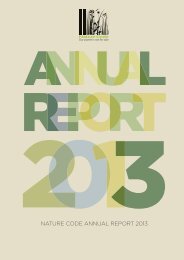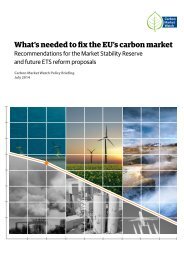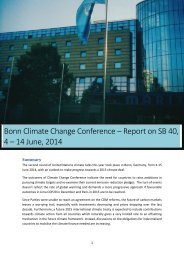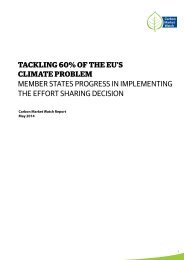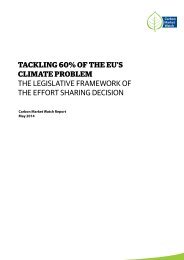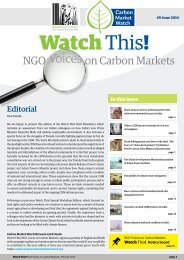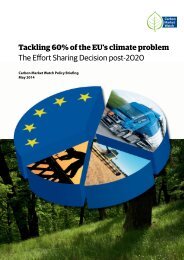Analysis of Europe’s 2030 Climate Ambition
You also want an ePaper? Increase the reach of your titles
YUMPU automatically turns print PDFs into web optimized ePapers that Google loves.
sectors not covered by the EU ETS and as such, covers more than 60% <strong>of</strong> the EU’s emissions. By the year<br />
2020, European countries are expected to have accumulated around 1.3 billion unused allowances<br />
under the ESD. This is due to two reasons:<br />
(i) The weak 2020 targets leading to a surplus <strong>of</strong> around 600 million tonnes <strong>of</strong> CO 2-eq 2 as actual<br />
greenhouse gas emissions are predicted to remain below the EU’s targets in each year during<br />
the 2013-2020 period.<br />
(ii) The use <strong>of</strong> up to 750 million<br />
international <strong>of</strong>fsets until<br />
2020 3 , since EU Member<br />
States can purchase more<br />
than half <strong>of</strong> their overall<br />
reduction obligations<br />
through carbon credits from<br />
<strong>of</strong>fsetting projects in<br />
developing countries.<br />
Contrary to the surplus emission<br />
allowances under the EU ETS, which<br />
will be carried-over automatically,<br />
the ESD does not foresee banking <strong>of</strong><br />
these pre-2020 surplus allowances<br />
for future use, unless explicitly<br />
decided otherwise. The Council conclusions don’t explicitly open doors for this option which can be<br />
interpreted as a very welcome step to safeguard the <strong>2030</strong> target from an additional loophole on top <strong>of</strong><br />
the excess allowances from the EU ETS.<br />
There was a considerable threat that the EU leaders would decide to allow banking <strong>of</strong> pre-2020 surplus<br />
allowances, because several countries, such as Poland, Hungary, Czech Republic, Slovakia, Bulgaria and<br />
Romania actively advocated for this. These countries, commonly referred to as “Visegrad+2 countries”,<br />
are projected to overachieve their 2020 targets, leaving them with a considerable amount <strong>of</strong> unused<br />
pre-2020 allowances. Allowing them and the other EU countries to use these “rights to pollute” in the<br />
<strong>2030</strong> climate framework, would have watered down the <strong>2030</strong> climate target by 5%.<br />
Postponing most <strong>of</strong> the climate action until later<br />
The European Council reconfirmed in February 2011 the EU’s objective <strong>of</strong> reducing greenhouse gas<br />
emissions by 80-95% by 2050 compared to 1990. Today’s decision by the EU leaders calls for a 40%<br />
reduction <strong>of</strong> greenhouse gas<br />
emissions between the 1990-<strong>2030</strong><br />
period and a further 40% emission<br />
reduction between the period <strong>2030</strong>-<br />
2050. See also the graph on the right<br />
by Ec<strong>of</strong>ys (2014) showing that the<br />
<strong>2030</strong> climate target <strong>of</strong> 40% is not on<br />
a linear reduction pathway from 2020<br />
to 2050. In other words: under the<br />
proposed emission reductions <strong>of</strong> 40%<br />
or less by <strong>2030</strong>, efforts need to<br />
heavily accelerate after <strong>2030</strong> to<br />
2<br />
European Commission (April 2014), Technical Annex to Kyoto <strong>Ambition</strong> Mechanism Report<br />
3<br />
European Environment Agency (2013). Trends and projections in Europe 2013<br />
3







